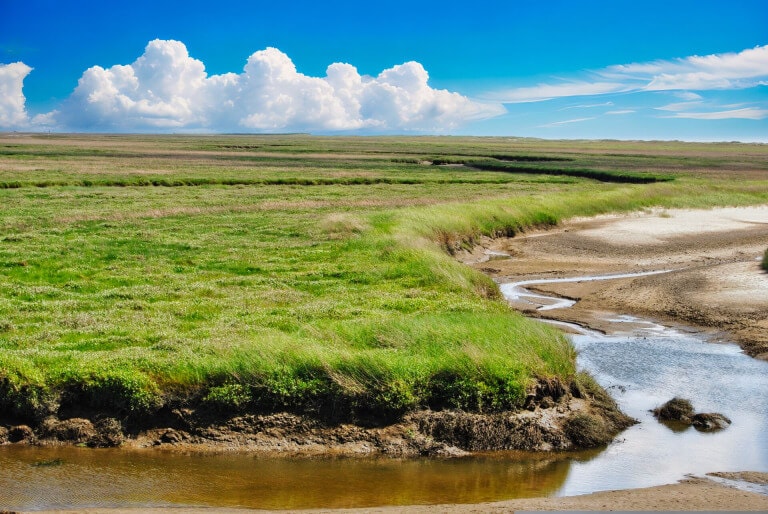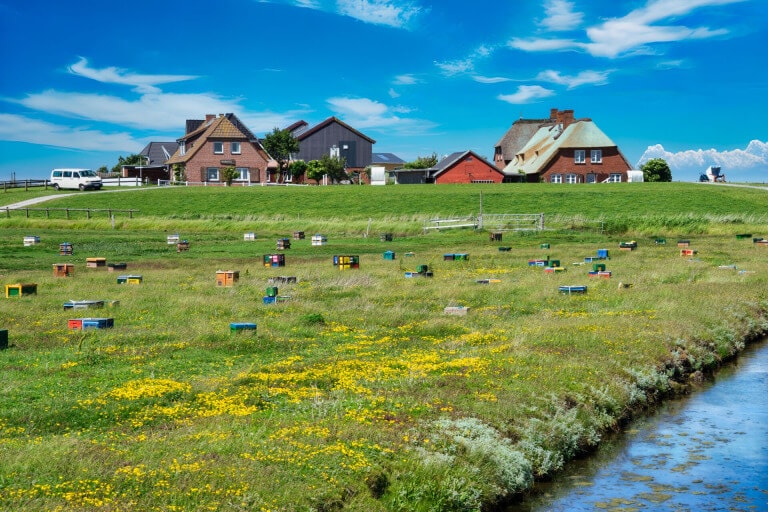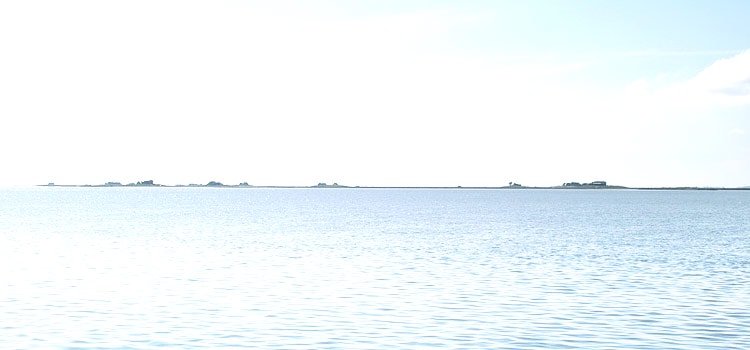Have you ever heard of the German Hallig Langeneß? If not, you are missing out on one of the most unique and interesting small coastal landscapes in the world. Langeneß is a small, low lying island in the Wadden Sea National Park, a UNESCO World Heritage Site, which can only be reached by ferry. Its distinctive and charming character makes it a popular destination for nature lovers, birdwatchers and adventurers alike.
History of Langeneß
Halligen – oder „Holland“ auf Friesisch – sind eine Gruppe von Gezeiteninseln vor der Küste von Deutschland und Dänemark. Es gibt zehn Halligen im Wattenmeer, von denen Langeneß die größte und bevölkerungsreichste ist. Diese Islands formed by the accumulation of sediments and sand carried by the tides, and are therefore constantly reshaped by the forces of nature.
The Hallig has a rich history dating back to the 16th century. For centuries it was a self-sufficient farming community whose inhabitants raised livestock and farmed on the fertile, marshy land. However, as sea levels rose and storms became more frequent, the island became increasingly vulnerable to flooding. Together with the decline of agriculture and the lure of better job opportunities on the mainland, this led to a decline in the population.
Today, only about 100 people live permanently on the island, whereas in the mid-19th century there were more than 800. Nevertheless, Langeneß is still an important cultural and historical place whose inhabitants work hard to preserve its unique character and way of life.
Geography and landscape of Hallig Langeneß
It is a relatively flat island, with an average height of only one meter above sea level. The island is about seven kilometers long and only about 1.5 kilometers wide at its widest point. The landscape is dominated by wetlands, salt marshes and tidal flats, which provide important habitats for a variety of birds and marine life. In fact, it is home to more than 160 different species of birds, making it a birdwatcher's paradise.
One of the most unique features is the Halligwarft, or "Hallighügel". These mounds were built by the islanders to have a safe retreat in case of flooding. They are made of earth and sod and can reach heights of up to four meters. Today, many of these mounds are used as lookout points and offer a breathtaking view of the surrounding landscape.
Activities on Langeneß
Even though it is a small and sparsely populated island, there is a lot to experience and see here. Visitors can explore the historic buildings. They can also take part in guided walks and tours led by local experts that provide insights into the history, ecology and culture of the island and Wadden Sea.
For nature lovers it is a paradise. The unique landscape provides important habitats for a variety of plant and animal species, and visitors can take part in bird watching tours, guided nature walks, and even mudflat hikes. The mudflats around the island are an incredibly diverse ecosystem, home to hundreds of species of plants and animals. They are also an important feeding area for migratory birds such as the Bar-tailed Godwit and the Knot.
Visitors can also enjoy water sports such as kayaking and stand-up paddleboarding.
Food and overnight stay
Despite the small size of the island, there are several accommodation options for visitors on Langeneß. Most of these accommodations offer a breathtaking view of the surrounding landscape.
Food and drink offerings on Langeneß are limited, but visitors can still enjoy the island's unique cuisine. Local specialties include fresh seafood such as shrimp and crab, as well as hearty stews and soups prepared with locally grown vegetables and herbs.
Ferry & Journey to Langeneß
If you want to explore the stunning landscapes and unique culture of Hallig Langeneß, getting there is easier than you might think. Although the German island is located in a remote corner of the North Sea there are several transportation options available to you.
A popular route is to take the long-distance train to Hamburg-Altona, Husum or Niebüll. From these stations, travelers can take Regionalexpress 6 to Bredstedt station. This train line is very convenient for travelers from the south, west or north of Germany.
At the train station in Bredstedt a shuttle bus will be waiting for you on the forecourt. This shuttle will take you directly to the ferry port of Schlüttsiel. The ferry is timed to the arrival of the shuttle bus, so that your journey is as seamless as possible.
Ferry to Langeneß
The ferry trip to Langeneß takes about 2 hours and 20 minutes, and there are up to two crossings per day. It is important to check the ferry's schedule before you travel, because the schedule can change depending on seasonal demand.
Conclusion
If you are looking for a unique and unforgettable coastal landscape, the German Hallig Langeneß is the place for you. This small but charming island offers visitors the opportunity to discover a rich cultural and historical heritage as well as a diverse and fascinating natural landscape. Whether you're a birdwatcher, nature lover, or just looking for a peaceful escape from the hustle and bustle of everyday life, Langeneß is the perfect destination. So why not pack your bags and head to this beautiful and unique island today?





